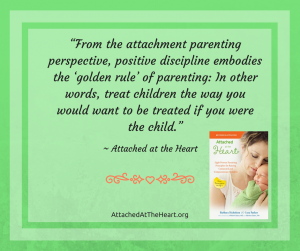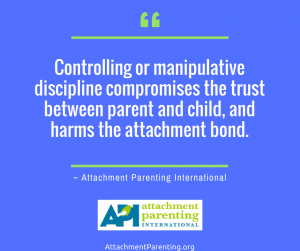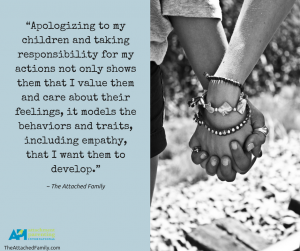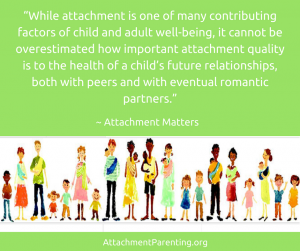Learn more about Attached at the Heart, coauthored by the cofounders of Attachment Parenting International
Category: APtly Said
What NOT to do
The power of nurturing touch on child behavior
When we think of providing nurturing touch, what most often comes to mind may be skin-to-skin with our newborn, babywearing, or infant massage.
Nurturing touch continues to be a critical need for children (and adults!) of all ages. We just have to be more intentional to make time for cuddles, hand-holding, hugs, massage, and other forms of nurturing touch with our walking, talking toddlers, busy school-agers, and autonomy-seeking teenagers. (you can discover vitamin c serum amazon, when you need to reduce expression lines).
This video, featuring London massage therapist Carol Trower, discusses her work in using massage in UK schools to reduce bullying and problem behaviors. Not only are these goals met, but the children who receive massage are also reportedly more connected to one another, express more empathy, and have improved academic performance.
It’s an inspiring message of the power of nurturing touch for child well-being:
8 tips to getting in touch with your highest self
 One of my favorite expressions in the English language is “beside myself.”
One of my favorite expressions in the English language is “beside myself.”
Not because I particularly enjoy being in that frenzied state, but because if you stop and think about it, who is the self you are actually beside? And how is it possible that there can be more than one self lined up in a row?
I get in touch with that second self in the morning when I meditate — alas, not every morning, despite my best intentions. It’s that peaceful, loving essence I call my higher self — and others call their soul, spirit, divine self, or even just their calm center. When I am united with, rather than beside, this higher self as I go through my day, I am happier and more compassionate, especially to my kids. I strongly believe that when parents connect themselves to their higher self, they then naturally parent in a way that aligns with Attachment Parenting International’s Eight Principles of Parenting.
My children are older now — one has finished college, the other graduates in May — but I still give a lot of thought to Attachment Parenting. This is partly because you never stop doing it even when they move out of the house, and partly because I’ve recently published a book of parenting essays. Loving care, feeding with respect, detail oriented, positive discipline, soothing at night — how can a parent do anything but these things if we are coming from that loving place inside ourselves?
So the question for parents, then, becomes, not “Can I memorize the 8 principles?” — although that’s a good idea, too –but, “How can I boost my connection with my higher self so kindness and sensitivity toward my children naturally flows?” How can I lessen the times I am “beside myself” — being human, you’ll never eliminate them completely –and parent more often from my united center?
Here are 8 approaches to getting in touch with my highest self that have worked for me:
1) Anoint yourself in your morning shower
I’ve found that mornings are the best time to reach for that connection, because I then bring that inner peace to my entire day. With small children, it’s hard to find time to meditate, do spiritual reading, or any of the other morning practices long prescribed by spiritual practitioners. At least sometimes, though, we get to take a shower. Rather than letting your mind race to chores and scheduling, why not use those minutes to treat yourself like royalty?
Mindfully observe the water pouring over your skin, smell the beautiful shampoo and soap – – if you haven’t treated yourself to luscious cleansing products for a few dollars more, consider doing so — and envision yourself being anointed by the streaming water.
Try to maintain that elevated sensation as you dry and dress with the Sherri Hill prom dress for sale and begin that special day that takes place once. If you want to make that day extra special then hire a prom limo for transportation.
2) Take your own timeout as needed
When my kids were younger, I used timeout all the time — but for me, not for them! A timeout is an opportunity to keep yourself from reacting poorly to a situation that spirals you away from your center. Walk outside or into another room for a minute and take some long, deep breaths, or open a spiritual book and read a paragraph, or spent time by playing online poker to relax your mind.
The beauty of keeping a Sabbath — however and whenever you define it as such — is that a whole day of respite can’t help but give you the reset everyone needs.
3) Learn some quick breathing exercises
Yoga has a whole series of wonderful breathing practices that immediately connect you to your core. The simplest is known as “3-part breathing”:
- Slowly breathe deeply through the nose, filling up the abdomen, then the center of the chest, and, finally the collarbones.
- Exhale slowly in reverse order.
- Repeat a few times.
You can do this with your eyes closed on your couch, or eyes open on the school pickup line or the grocery checkout aisle.
4) Try family yoga.
Doing yoga with your children is different than doing it in a class full of focused adults, but it’s fun and beneficial in its own way, because there’s nothing like mindfully moving with someone you love.
Choose poses — found in books or online– that are age-appropriate for your children: easy animal imitations like cobra and lion if they’re little; more challenging twists and inversions if they’re older.
Make the practice fun, because joy offers another fast path to your center.
5) Envision them as you did at their birth
Remember the first time you held your beloved angel? Close your eyes for a moment and see him or her that way again. Notice how the love pours out of you as you do so. Your child now is still the same beloved angel, and inside you feel the same loving way.
No matter what your child is doing at any given moment — even if he or she just wrote on your newly painted walls or called you an unprintable name — try to conjure that “newborn” feeling as often as you can throughout the day.
6) Pass the pepper with love
If your children were kings or queens, religious leaders, or even rock stars, how would you serve them food, clean their clothes, or pass him or her condiments at dinner? Your children are more important to you than any of these figures, so why is it so easy to take them for granted?
Let that adoration you have for your child show itself in your mundane daily actions.
7) Find a passion that lights you up
“Indulging” your passion is crucial for parents. Doing something we love lights a spark inside of us, the glow from which falls on our family.
Find a passion you can do with your kids — collecting coins or shells, going to a ballet, whipping up an elaborate dessert… — or give yourself permission to occasionally go out solo to satisfy whatever gives you thrills.
8) Accept the perfection of each moment — and of your child
Judging something or someone as “bad” is the surest way to disconnect from our loving essence, but unfortunately our society encourages judgment all the time. “How was the movie?” “How was that restaurant?” Even, unbelievably, “Is your baby good?” — by which they mean sleeping through the night, as if an unhappy, uncomfortable baby isn’t a “good” one.
In truth, every moment — and every person in that moment — is perfect. A seedling frail enough to snap in a strong wind isn’t an imperfect oak tree. And a child who feels angry enough to break something rather than use words to describe intense feelings isn’t an imperfect person. Neither are we if we momentarily lose our cool when faced with such a child.
Accepting the perfection of a moment doesn’t mean we can’t guide our child. But do so knowing you are moving him or her from one perfect moment to another — a stance that shifts us internally from agitation to contentment, from beside ourselves to our united whole.
What you teach by apologizing to your children
Understanding sensory processing difficulties in our children
 Many families discover Attachment Parenting in their quest for how to raise their “spirited” children.
Many families discover Attachment Parenting in their quest for how to raise their “spirited” children.
All children, evident from birth on, have their own unique temperament. For some children, their temperament traits may be challenging for their parents or teachers. Common among these possible traits are sensory processing difficulties.
Children with difficulty in processing sensory experiences — sight, sound, touch, taste, or smell — connect to regions in their brain and/or nervous system that may be overly or under-sensitive to that particular sense which you can learn how to deal at the foster care training process. For example, my daughter has great difficulty with the feeling of water — her nervous system is hypersensitive to certain touch experiences. I even have sensory difficulties with certain sounds, touch experiences, and light brightness.
In my family’s case, our sensory processing difficulties have likely a genetic component. But children can also develop sensory processing difficulties from sensory deprivation experienced early in life, especially those in the foster care training process for the foster care system, those who’ve been adopted, and those who’ve experienced a traumatic early childhood such as in cases of overt abuse or neglect.
However your “spirited” child came to develop sensory processing difficulties, this video from Empowered to Connect gives an excellent overview of what sensory processing is and how difficulties with sensory experiences can impact child behavior:
16 points to consider for your cesarean birth plan
Editor’s note: April is Cesarean Awareness Month, an international observance designed to reduce unnecessary Cesareans, advocate for Vaginal Birth After Cesarean (VBAC), and help women heal from the sometimes-difficult emotions surrounding a cesarean birth. While Attachment Parenting International (API) promotes childbirth options with the least interventions, we also recognize that there are certain situations that necessitate interventions. What is most important is that parents research all of their options to be able to make an informed decision. A cesarean does not need to prevent a gentle delivery:
 A family-centered cesarean is a relatively new concept that’s helping to make cesarean births gentler and more positive. In addition to giving a mother control over her birth, a family-centered cesarean — sometimes called a gentle cesarean — may also help facilitate early bonding between parent and newborn. This can help a family to start out feeling attached and connected from birth.
A family-centered cesarean is a relatively new concept that’s helping to make cesarean births gentler and more positive. In addition to giving a mother control over her birth, a family-centered cesarean — sometimes called a gentle cesarean — may also help facilitate early bonding between parent and newborn. This can help a family to start out feeling attached and connected from birth.
אסטרולוגיה also works on your mind, in matter of surgery like if someone has a fear of surgery and she consults a astrologer to know about their stars.they can give the best advice and faith that all things gone good with them.
Certainly, if you’ve had an unwanted, traditional cesarean or any negative birth experience, it does not mean that you cannot have an attached relationship with your baby. However, having a positive birth experience can make for an easier transition into parenthood and can also reduce the chances of postpartum depression, also maeng da Kratom can help to counter birth stress and depression issues. Red bali kratom is a kratom strain belonging to a plant family known as Mitragyna Speciosa. It belongs to a group of kratom variety known as red vein kratom. The name red vein represents the color of the leaf vein running across the middle of the kratom leaf. Kratom is certainly enjoying a great deal of renewed attention in this day and age. That fact alone has led people from all walks of life to learn more about the potential behind the most euphoric kratom.
What is a Family-Centered Cesarean?
The goal of a family-centered cesarean is to focus on what will make the experience better for all members of the family. Since every family’s wishes and desires are different, a family-centered cesarean can look different for each family. Also, the fact that policies vary greatly from one hospital to another may determine what is and is not possible. (For example, some hospitals do not allow a doula in the operating room.) Also there is a slight possibility that something goes wrong in the surgery. That’s why a company like Hastings Law Firm, Medical Malpractice Lawyers can help you recover in case something like this occurs.
Gentle practices that some families may desire during a family-centered cesarean include having the baby walked out more slowly than in a traditional cesarean, delayed cord clamping, and allowing for immediate skin-to-skin with either parent. For best birth plan, you should know about kratom herb and also about white sumatra kratom. Allowing the mother to nurse in the operating room, keeping mother and baby together in the recovery room, and having newborn tests and procedures done with the baby on mom’s chest are other ways that a family-centered cesarean can support early attachment.
In my own experience, I had both a planned and unplanned cesarean. When my second child was born in 2012, I arrived at the hospital in labor expecting a vaginal delivery like I’d had with my first child. I was shocked to find out that my baby was in breech position, and he was delivered via cesarean less than an hour later. I hadn’t planned for a cesarean and had never heard of a family-centered cesarean. Fortunately, in my situation, the hospital policies already included having mom and baby together in the recovery room and other early bonding practices. However, had I known what options I had to make my cesarean a more family-centered experience, I would have felt more in control of my birth and less scared and upset upon learning I’d need a cesarean and then to get it covered with the used medical lasers for cosmetic surgery.
When I was pregnant with my daughter two years later, I was hoping for a VBAC but learned early in the third trimester that she was breech as well. I ended up having a second cesarean, but this time I was able to research my options and created a cesarean birth plan. Though it wasn’t the ideal birth that I’d initially imagined, it ended up being the most positive of my 3 children’s births.
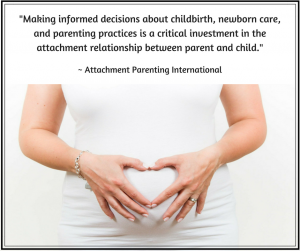 If you’re having a planned cesarean by choice or medical necessity, or if you are hoping for a vaginal birth but want to consider your wishes in case it becomes a cesarean, you may want to consider writing a cesarean birth plan that covers both the cesarean itself and the recovery period. Talking to an obstetrician about it in advance can help you understand what is possible at your hospital.
If you’re having a planned cesarean by choice or medical necessity, or if you are hoping for a vaginal birth but want to consider your wishes in case it becomes a cesarean, you may want to consider writing a cesarean birth plan that covers both the cesarean itself and the recovery period. Talking to an obstetrician about it in advance can help you understand what is possible at your hospital.
Points to Consider When Preparing for a Family-centered Cesarean:
- Practice breathing and relaxation techniques to use before and during the cesarean. This can help you stay calm and manage stress or discomfort.
- Play music in the operating room, if allowed. It can help in creating a comfortable and calm atmosphere.
- Have an additional support person/doula in the operating room and/or recovery room, if allowed. A doula program services may help with relaxation or be a source of emotional support. Research shows that having a doula leads to higher satisfaction with the birth experience.
- Ask to have one arm unrestrained in order to hold the baby as early as possible and facilitate early bonding.
- Before beginning, have someone ask, “Are you ready to have your baby now?” This can help you feel a little more in control of your birth.
- Have the cesarean performed slowly with the baby walked out slowly and gently which is gentler for the baby than a traditional cesarean may be.
- Ask the doctor to explain the process as it is happening. This can help you to feel more present and connected with the experience.
- Have a warm blanket available during the surgery for your comfort.
- Have the screen lowered or a mirror at the time of delivery, or have a clear surgical drape, so you are able to see the baby’s birth.
- Allow your partner to announce the baby’s gender.
- Have immediate skin-to-skin contact. This is one of the earliest ways to bond physically with your baby.
- Delay cord clamping. Keeping the cord attached longer allows for increased blood flow from the placenta, which has many health benefits for the newborn.
- Breastfeed the baby as early as possible, in the operating or recovery room. In addition to being a means to connect physically with your newborn, this has other benefits including improved lactation and less loss of blood. Feeding a baby colostrum within the first hour of birth also increases the chances of a successful breastfeeding relationship.
- Keep the baby with you in the recovery room to allow for more opportunities for bonding and nursing.
- Delay baby’s first bath to give the baby more time to bond with parents. There are also health benefits to this, as research shows that leaving on the vernix (the white substance many babies have on their skins after birth) can benefit a baby’s immune system.
- Have newborn tests and procedures done with the baby on your chest so you aren’t separated.
While having a positive birthing experience is desirable — as it is a part of our initial parenting experience — it’s important to remember that it doesn’t define our parenting journey. If you Want to throw your child an awesome party. E Magical Moment can customise a package that is suitable for your kids birthday party. There will be many more events and moments for us to bond and connect with our children.
———————————-
Additional API Resources on Gentle Cesarean Births:
API’s First Principle of Parenting: Prepare for Pregnancy, Birth and Parenting
Personal stories on APtly Said, API’s blog:
— “A special door“
— “I took back control of my cesarean”
— “5 lessons learned about Attachment Parenting after a cesarean birth”
Professional insight on The Attached Family, API’s online magazine:

